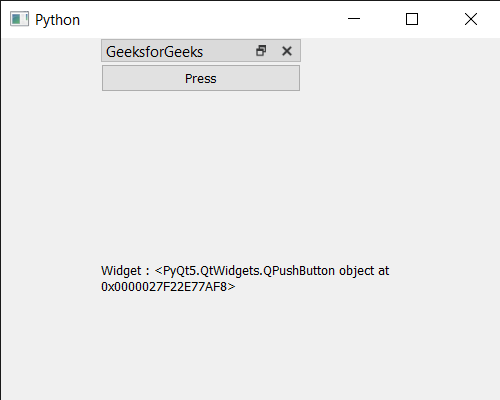En este artículo veremos cómo podemos obtener el widget del QDockWidget. QDockWidget proporciona el concepto de widgets de base, también conocidos como paletas de herramientas o ventanas de utilidades. Las ventanas del muelle son ventanas secundarias ubicadas en el área del widget del muelle alrededor del widget central en una QMainWindow (ventana original).
Podemos agregar un widget al widget de base con la ayuda del setWidgetmétodo, el widget puede ser cualquier widget o incluso un solo widget que contenga muchos widgets secundarios pequeños. Junto con el widget de base, el widget configurado también se mueve con él. De forma predeterminada, ningún widget está configurado en el muelle.
Para hacer esto, usaremos
widgetel método con el objeto del widget del muelle.Sintaxis: muelle.widget()
Argumento: no requiere argumento
Retorno : Devuelve QWidget
A continuación se muestra la implementación.
# importing libraries
from PyQt5.QtWidgets import *
from PyQt5 import QtCore, QtGui
from PyQt5.QtGui import *
from PyQt5.QtCore import *
import sys
class Window(QMainWindow):
def __init__(self):
super().__init__()
# setting title
self.setWindowTitle("Python ")
# setting geometry
self.setGeometry(100, 100, 500, 400)
# calling method
self.UiComponents()
# showing all the widgets
self.show()
# method for components
def UiComponents(self):
# creating dock widget
dock = QDockWidget("GeeksforGeeks", self)
# push button
push = QPushButton("Press", self)
# setting widget to the dock
dock.setWidget(push)
# setting geometry tot he dock widget
dock.setGeometry(100, 0, 200, 30)
# creating a label
label = QLabel("GeeksforGeeks", self)
# setting geometry to the label
label.setGeometry(100, 200, 300, 80)
# making label multi line
label.setWordWrap(True)
# getting widget of the dock
value = dock.widget()
# setting text to the label
label.setText("Widget : " + str(value))
# create pyqt5 app
App = QApplication(sys.argv)
# create the instance of our Window
window = Window()
# start the app
sys.exit(App.exec())
Producción :
Publicación traducida automáticamente
Artículo escrito por rakshitarora y traducido por Barcelona Geeks. The original can be accessed here. Licence: CCBY-SA